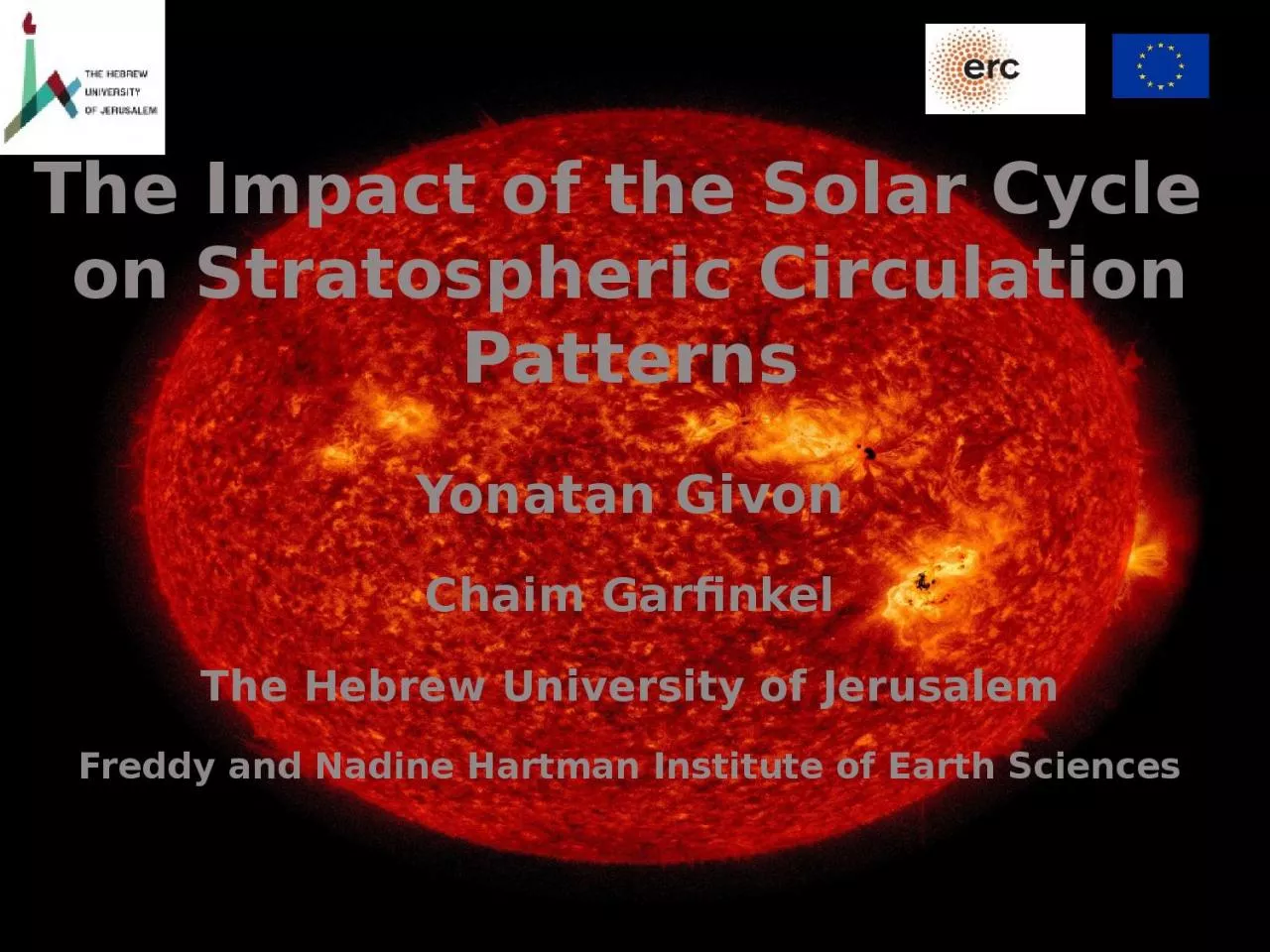

on Stratospheric Circulation Patterns Yonatan Givon Chaim Garfinkel The Hebrew University of Jerusalem Freddy and Nadine Hartman Institute of Earth Sciences Solar variability Well understood impacts on climate ID: 1024309
Download Presentation The PPT/PDF document "The Impact of the Solar Cycle" is the property of its rightful owner. Permission is granted to download and print the materials on this web site for personal, non-commercial use only, and to display it on your personal computer provided you do not modify the materials and that you retain all copyright notices contained in the materials. By downloading content from our website, you accept the terms of this agreement.
1. The Impact of the Solar Cycle on Stratospheric Circulation PatternsYonatan GivonChaim GarfinkelThe Hebrew University of JerusalemFreddy and Nadine Hartman Institute of Earth Sciences
2. Solar variabilityWell understood impacts on climate:Daily variationsSeasonal variationsLess well understood: Milankovitch cycles11 year solar cycle27 day rotation periodSmaxSmin
3. The Solar Cycle~11 year period~0.1% variations in TSI~5% variations in UVPast estimations of up to 30% variations in UV (Maunder Minimum, Krivova and Solanki, 2005)a sunspot
4. The Stratospheric “Pathway”after Mitchell 2015:1 : initial heating anomaly2: reduced BDC3a: downward propagation of zonal wind anomaly3b: secondary heating anomaly4: poleward shift of the tropospheric jets
5. GoalsEvaluating the solar cycle’s impact on the stratosphere:How does the impact reach the winter polar stratosphere where there is no sunlight?What is the time scale for the impact? Should we expect a surface impact on the 27-day solar rotation timescale? Just on the 11-year timescale?
6. MiMAPrimitive equations based aquaplanet GCMFull radiation scheme (RRTMG). Non-interactive ozone profile.Topography, land-sea contrast, east-west q fluxes
7. Realism of DJF stationary waves when all forcings included (Z* at 300hPa)ERA-5 reanalysisALL,(+east-west Q-fluxes,+land/sea contrast+topography)Garfinkel et al, in review in J Clim.
8. Z* at 300hPa, 50N as realistic as CMIP5 modelsGarfinkel et al, in review in J Clim.
9. Similarly, Z* at 50hPa, 50N as realistic as CMIP5 modelsGarfinkel et al, in review in J Clim.
10. Simulated Solar Cycle
11. MiMA switch-on experimentsControl run with average UV intensity.Branching with UV radiation increased (decreased) by 30% for Smax (Smin), starting at January 1st.Repeat X30, and run each branch run through the end of February.Compare Smax to Smin.
12. Temporal evolutionWind anomaly propagate down alongside temperature anomalyImpact at tropopause evident after ~4 weeksSPV response significant when comparing Smax to SmintemperatureZonal wind
13. Temporal evolution – TEM circulationTropical BDC acceleration gives way to sub-polar deceleration.Anomalous down-welling across the mid-latitude upper stratosphere.Anomalous up-welling in subpolar latitudes.
14. Thermal wind on equatorial β planeH~7kmL~1000km(10o)U_z=5m/s/kmT~3K(a) first two daysEQ30N30S60NNPEPFD>0EPFD<0 WarmwesterliesShortwaveabsorptionBDCSchematic of the response to enhanced UV50 hPaTropopause1 hPaEPFD>0EPFD<0 WarmShortwaveabsorption3westerliesEPFD>0BDCBDCEQ30N30S60NNP(b) After ~20 daysCold
15. Thermal TEM budgetWeek 1: SW heating across most of the stratosphere resulting in ~2K/day warming.Week 2-3: LW cooling in mid-latitudes countered by anomalous down-welling.Week 4: The SPV cools significantly due to anomalous LW cooling and up-welling.Week 1Week 3Week 2Week 4
16. Zonal momentum TEM budgetWeek 1Week 2Week 3Week 4 abcdeabcdeaabdWeek 1Week 2Week 3Week 4fv* in subtropics leads to acceleration of zonal wind. positive EPFD dominates the SPV and leads to poleward extension of region with enhanced westerlies (a).Countered but not balanced by fv* (b & c).Other terms contribute.Sum of forcing propagate downwards to the tropopause
17. Zonal momentum TEM budget aWeek 3Week 4positive EPFD dominates the SPV (a).Countered but not balanced by fv* (b & c).Other terms contribute.Sum of forcing propagate downwards to the tropopause
18. Zonal momentum TEM budgetWeek 1Week 2Week 3Week 4
19. MiMA switch-on resultsImmediate response of tropical T. Polar vortex response peaks after ~4 weeks.
20. MiMA switch-on resultsHints of a tropospheric response after 20 days, but robust only after ~30 days.
21. Idealized model results:30% variations in UV intensity (i.e. Maunder minimum) result in:>15 K warming of tropical upper stratosphere>15 m/s zonal wind anomalies at the SPV5m/s/day EPFD anomalies at the SPVAccelerated BDC in the tropics Decelerated BDC at mid-latitudesPossible pole-ward shift of tropospheric jet
22. DisclaimersIn MiMA: no chemistry. No cloud effects.Uncoupled ocean.Amplified solar forcing.No lower stratospheric secondary maximum, but this maximum may be an artifact in any event (Chiodo et al 2014)Timescale is too slow for the 27-solar rotation period to have much of an impact
23. Thank you for listening!